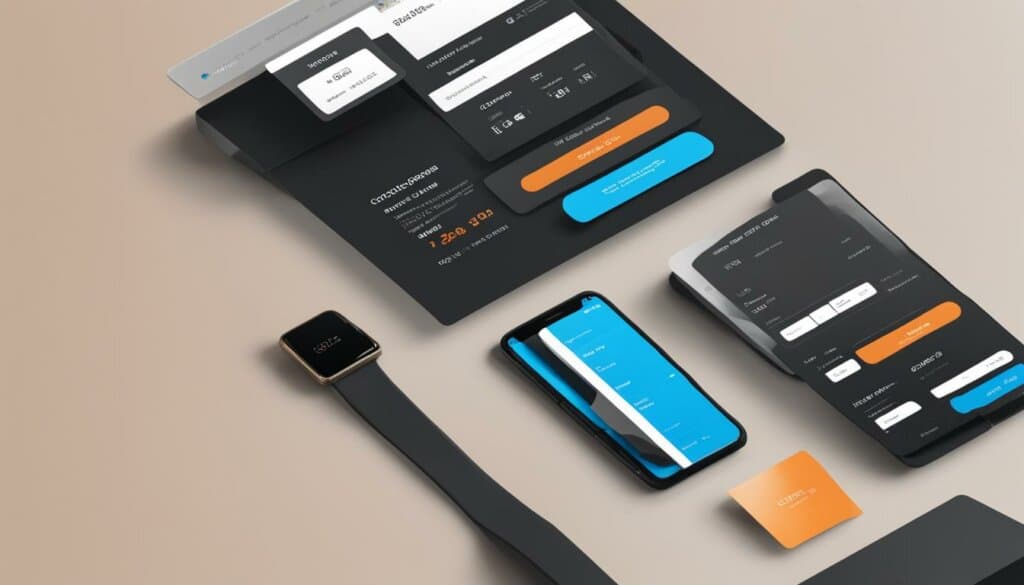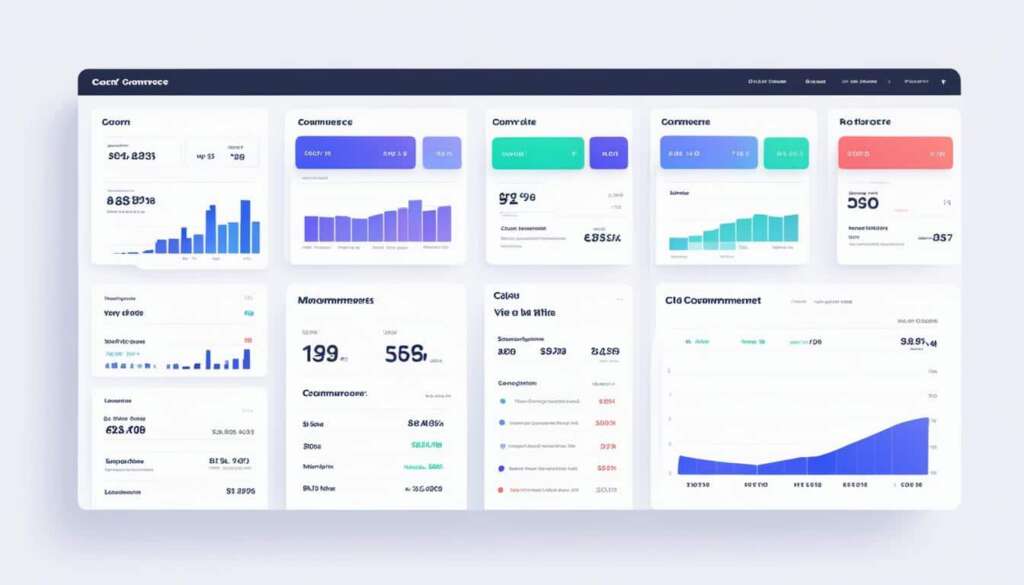Table of Contents
Welcome to our article on e-commerce UX tips for conversion optimization. In today’s competitive online marketplace, it is essential to prioritize the customer experience in order to drive conversions and maximize business growth. By understanding the impact of user experience on conversion rates, you can implement effective strategies to enhance your e-commerce website’s performance and achieve your conversion goals.
Understanding E-commerce Conversion Rate Optimization (CRO)
In the world of e-commerce, conversion rate optimization (CRO) is a critical metric that directly impacts business goals. By focusing on improving the conversion rate, businesses can maximize their online sales and revenue. But what exactly is e-commerce CRO? Let’s explore.
E-commerce CRO involves making incremental improvements to your website or online store in order to enhance the conversion rate. The conversion rate represents the percentage of visitors who take the desired action, such as making a purchase, filling out a form, or subscribing to a newsletter. By optimizing your website for conversions, you can increase the likelihood of visitors becoming customers.
Measuring conversions is essential for e-commerce CRO. It allows you to track the effectiveness of your optimization efforts and identify areas that require improvement. By analyzing conversion data, you can gain valuable insights into customer behavior, preferences, and pain points. This data-driven approach enables you to make informed decisions to improve user experience and drive conversions.
The Importance of Measuring Conversions
Measuring conversions provides valuable insights into the effectiveness of your e-commerce website. It allows you to determine which elements of your website are driving conversions and which ones may be hindering them. By identifying areas of improvement, you can implement targeted strategies to optimize your website and increase the conversion rate.
Moreover, measuring conversions helps you align your optimization efforts with your business goals. By understanding the impact of conversion rate improvements on your bottom line, you can prioritize and allocate resources effectively. Whether your goal is to increase sales, generate leads, or boost subscriptions, measuring conversions plays a crucial role in evaluating the success of your e-commerce CRO initiatives.
“Measuring conversions is like using a compass to navigate the e-commerce landscape. It guides you in the right direction and helps you make data-driven decisions for better business outcomes.”
The Impact of E-commerce CRO on Business Goals
When it comes to enhancing business goals, e-commerce CRO plays a vital role. By improving your conversion rate, you can achieve a variety of objectives, such as:
- Increase online sales and revenue
- Boost customer acquisition and retention
- Maximize the return on ad spend (ROAS)
- Improve customer satisfaction and loyalty
- Enhance brand reputation and credibility
By focusing on conversion rate optimization, you can create a seamless and user-friendly shopping experience that motivates visitors to convert into customers. It allows you to fine-tune every aspect of your website, from navigation and design to product descriptions and checkout process, to ensure a smooth journey for your potential buyers.
| Benefits of E-commerce CRO | Impact on Business Goals |
|---|---|
| Improved user experience | Increase in customer satisfaction and loyalty |
| Reduced bounce rates | Higher engagement and longer time spent on the website |
| Increased conversion rates | Increase in online sales and revenue |
| Optimized checkout process | Higher completion rates and reduced cart abandonment |
The Impact of UX on Conversion Rates
In the world of e-commerce, user experience (UX) plays a crucial role in determining conversion rates. A seamless and optimized user experience can significantly enhance the chances of converting website visitors into paying customers. By understanding the impact of UX on conversions, businesses can make informed decisions and allocate their optimization efforts effectively.
The Relationship Between UX and Conversions
A positive user experience is directly linked to higher conversion rates. When customers have a smooth and enjoyable experience while navigating an e-commerce website, they are more likely to trust the brand and complete their purchase. On the other hand, a poor UX can lead to frustration, confusion, and ultimately, abandoned shopping carts.
Optimization efforts should focus on elements that enhance the user experience, such as intuitive website navigation, clear calls-to-action, fast page load times, and mobile responsiveness. By prioritizing these aspects, businesses can create a user-friendly environment that encourages conversions.
“A smooth and optimized user experience can significantly enhance the chances of converting website visitors into paying customers.”
The Importance of UX Optimization
Optimizing the user experience on e-commerce websites is not just a nice-to-have; it’s essential for achieving conversion goals. The seamless flow from landing page to checkout page, intuitive search functions, and user-friendly product information are all critical to guiding customers smoothly through the buying process.
Efficient UX optimization efforts involve thorough research and analysis of user behavior, preferences, and pain points. By understanding customers’ needs and expectations, businesses can tailor their website design, content, and functionality to provide a more personalized and satisfying experience.
Furthermore, a well-optimized UX can lead to long-term benefits such as increased customer loyalty, higher customer satisfaction, and positive word-of-mouth. When customers have a positive experience, they are more likely to return for future purchases and recommend the brand to others.
The Role of Aesthetics and Usability
In addition to functionality, aesthetics and usability are crucial components of a successful user experience. Creating visually appealing designs and layouts that align with the brand’s identity can help capture visitors’ attention and establish trust.
Images play a significant role in improving the user experience. High-quality product images and relevant visuals can convey credibility, inspire confidence, and provide necessary information to potential customers. Including clear and detailed product images can reduce uncertainties and increase the likelihood of conversions.
Usability also plays a pivotal role in UX optimization. Businesses need to ensure that their website is easy to navigate, with clear menu structures and search functionalities. Simplifying the checkout process by eliminating unnecessary steps, reducing form fields, and providing progress indicators can significantly enhance the user experience and boost conversion rates.
Key Takeaways
- A positive user experience is directly linked to higher conversion rates in e-commerce.
- Optimization efforts should focus on elements such as intuitive navigation and clear calls-to-action.
- Understanding customer behavior and preferences is crucial for effective UX optimization.
- Aesthetics and usability play a significant role in enhancing the overall user experience.
Key Elements of e-commerce Conversion Rate Optimization
In the world of e-commerce, optimizing the conversion rate is crucial for generating sales and maximizing revenue. To achieve success in this endeavor, it’s essential to focus on key elements that can significantly impact the conversion rate. In this section, we will explore these essential elements and delve into how they contribute to the overall conversion rate optimization process.
Optimizing the Checkout Process
The checkout process is a critical stage in the customer journey, where a potential sale can be won or lost. Ensuring a streamlined and user-friendly checkout process is vital for minimizing cart abandonment and maximizing conversions. By reducing friction and simplifying the steps required to complete a purchase, you can create a seamless checkout experience that encourages customers to proceed with their transaction.
Trust Signals and Secure Payment Options
Establishing trust with your online customers is paramount to achieving higher conversion rates. Incorporating trust signals throughout the e-commerce website can instill confidence in customers and alleviate any concerns they may have about sharing sensitive information. Display trust badges, customer reviews, and secure payment icons prominently to reassure customers that their data is safe and trustworthy.
High-Quality Product Images
The visual appeal of your products can significantly impact a customer’s decision-making process. High-quality product images, showcasing your offerings from various angles, can help customers visualize the product and understand its features better. Invest in professional product photography and ensure that your images accurately represent the product’s color, size, and other essential details. By providing visually appealing product images, you can enhance the overall user experience and boost conversion rates.
Reducing Unnecessary Form Fields
Asking for too much information during the checkout process can deter customers from completing their purchase. Streamline your form fields by only asking for the necessary information required to fulfill the transaction. By reducing unnecessary form fields, you can minimize friction and make the checkout process faster and more convenient. This simplicity can lead to higher conversion rates and a smoother customer experience.
By optimizing these key elements of e-commerce conversion rate optimization, you can create an enhanced user experience that drives higher conversion rates and boosts your online business’s success.

Enhancing Mobile User Experience
In today’s digital landscape, mobile optimization is vital for the success of e-commerce websites. With the increasing number of mobile users, it’s crucial to ensure that your website delivers a seamless and user-friendly experience across all devices. In this section, we will explore the importance of mobile optimization and provide valuable insights to enhance mobile user experience (UX) for better conversion rates.
The Importance of Mobile Optimization
Mobile optimization is about creating a responsive and visually appealing website that adapts to different screen sizes and provides optimal performance. By optimizing your website for mobile devices, you can tap into a larger audience and maximize conversions. Here are some key reasons why mobile optimization matters:
- Mobile users have surpassed desktop users, making it crucial to cater to their needs.
- Google prioritizes mobile-friendly websites in its search rankings, improving visibility and organic traffic.
- A seamless mobile experience enhances user satisfaction and encourages repeat visits and purchases.
With these factors in mind, optimizing your website for mobile devices should be a top priority.
Common Mobile Pitfalls to Avoid
Despite the importance of mobile optimization, many e-commerce websites still fall short in providing a seamless mobile experience. Here are some common pitfalls to avoid:
- Slow Loading Speed: Mobile users expect quick page load times. Optimize your website’s speed by compressing images, leveraging browser caching, and minimizing server response time.
- Unintuitive Navigation: Ensure that your website’s navigation is intuitive and easy to use on mobile devices. Utilize clear menus, prominent search bars, and strategically placed call-to-action buttons.
- Unresponsive Design: A responsive design ensures that your website adapts smoothly to different screen sizes and orientations, providing a consistent user experience.
- Poor Form Fields: Streamline the checkout process by optimizing form fields for mobile users. Use auto-fill options, minimize the need for manual input, and ensure that the form is easy to fill out on a small screen.
- Small or Inaccessible Buttons: Buttons and clickable elements should be appropriately sized and spaced to prevent accidental clicks on mobile devices. Make sure they are easy to tap with a finger.
Tips for Mobile Optimization
To enhance mobile user experience and boost conversion rates, implement these tips for mobile optimization:
“Mobile optimization is not just about having a smartphone-friendly website; it’s about creating a delightful experience that drives conversions and builds trust.”
| Tips for Mobile Optimization | Benefits |
|---|---|
| Implement responsive design | Adapts to different screen sizes and orientations, providing a consistent experience |
| Optimize images for mobile | Fast loading speeds and improved user experience |
| Streamline the checkout process | Reduced cart abandonment and increased conversions |
| Utilize mobile-friendly forms | Easier form completion and higher completion rates |
| Implement mobile-specific search functionality | Easier navigation and faster access to desired products |
| Optimize page speed | Improved user experience and reduced bounce rates |
By implementing these tips, you can create a seamless and visually appealing mobile experience that will keep your customers engaged and drive conversions.
In the next section, we will dive into the best practices for e-commerce conversion optimization, focusing on key elements that can significantly impact your website’s performance and success.
Best Practices for E-commerce Conversion Optimization
When it comes to e-commerce conversion optimization, implementing the right strategies can make a significant difference in driving sales and improving customer experience. In this section, we will explore some of the best practices that can help maximize conversions on your online store.
Conveying Unique Selling Propositions (USP)
Your unique selling proposition (USP) is what sets your products apart from the competition. It’s crucial to clearly communicate your USP to potential customers, highlighting the key benefits of your products or services. Whether it’s offering free shipping, a price match guarantee, or a superior quality guarantee, make sure your USP is prominent and compelling on your website.
Navigation plays a vital role in guiding visitors through your e-commerce site. A clear and intuitive navigation structure improves the user experience, making it easier for customers to find what they’re looking for. Ensure that your navigation menu is easily accessible and well-organized, with logical categories that align with your product offerings.
Providing Comprehensive Product Information
Product information is crucial for online shoppers. Make sure to provide detailed and accurate descriptions of your products, including specifications, dimensions, materials, and any other relevant information that can help customers make informed purchase decisions. High-quality product images that showcase different angles and features should accompany the descriptions.
Leveraging Social Proof
Social proof, such as customer reviews and testimonials, can significantly impact the trust and credibility of your online store. Displaying authentic reviews and ratings from satisfied customers can instill confidence in potential buyers, encouraging them to proceed with their purchase. Consider integrating social proof elements throughout your product pages and checkout process.
“According to a study by XYZ Research, displaying customer reviews can increase conversions by up to 30%.”
By implementing these best practices, you can create a seamless and persuasive shopping experience for your customers, ultimately boosting your e-commerce conversion rates. Keep in mind that continuous testing and refinement are essential to ensure the effectiveness of these strategies.

| Best Practices for E-commerce Conversion Optimization | Description |
|---|---|
| Conveying Unique Selling Propositions (USP) | Clearly communicate what sets your products apart from the competition. |
| Improving Navigation | Enhance the user experience by implementing a clear and intuitive navigation structure. |
| Providing Comprehensive Product Information | Ensure detailed and accurate product descriptions, accompanied by high-quality images. |
| Leveraging Social Proof | Showcase authentic customer reviews and testimonials to build trust and credibility. |
Conclusion
In conclusion, effective e-commerce conversion rate optimization (CRO) is crucial for increasing conversion rates and improving the overall customer experience. By implementing the tips and best practices outlined in this article, you can optimize your e-commerce website for higher conversions and ultimately boost your online business success.
Conversion optimization is an ongoing process that requires continuous monitoring and improvement to stay ahead of the competition. It involves making incremental improvements to various elements of your website, such as the checkout process, trust signals, product images, and form fields. These optimizations, combined with a focus on user experience (UX), can have a significant impact on your conversion rates.
Remember, the key to successful conversion optimization is to understand your target audience, their behavior, and their needs. By providing a seamless and engaging user experience, you can build trust, enhance customer satisfaction, and ultimately increase conversions. Keep in mind that every improvement you make, no matter how small, can contribute to the overall success of your e-commerce business.
FAQ
What is e-commerce CRO?
E-commerce CRO, or e-commerce conversion rate optimization, involves making incremental improvements to enhance the conversion rate of an e-commerce website. It focuses on optimizing different elements to improve the overall user experience and increase the likelihood of customers completing a desired action, such as making a purchase.
Why is it important to measure conversions?
Measuring conversions is important because it allows businesses to understand the effectiveness of their marketing efforts and website performance. By tracking conversions, businesses can identify areas for improvement and make data-driven decisions to optimize their e-commerce strategies and achieve their business goals.
How does user experience impact conversion rates?
User experience plays a significant role in conversion rates. A better user experience, with intuitive navigation, clear product information, and streamlined checkout processes, can instill trust and confidence in customers, increasing their likelihood of converting. By optimizing the user experience, businesses can improve conversions and enhance customer satisfaction.
What are the key elements of e-commerce conversion rate optimization?
The key elements of e-commerce conversion rate optimization include optimizing the checkout process by incorporating trust signals and offering secure payment options. It also involves using high-quality product images to showcase products effectively and reducing unnecessary form fields to simplify the customer journey and minimize friction.
Why is mobile optimization important for e-commerce conversion rates?
Mobile optimization is crucial because an increasing number of customers are using mobile devices to browse and make purchases. By optimizing the mobile user experience, businesses can ensure that their websites are responsive, easy to navigate, and provide a seamless shopping experience. Failure to do so can result in lost conversions and dissatisfied customers.
What are some best practices for e-commerce conversion optimization?
Some best practices for e-commerce conversion optimization include conveying unique selling propositions (USPs) effectively, improving website navigation for easy exploration, providing comprehensive product information to assist customers in making informed decisions, and leveraging social proof, such as customer reviews and testimonials, to build trust and increase conversions.













